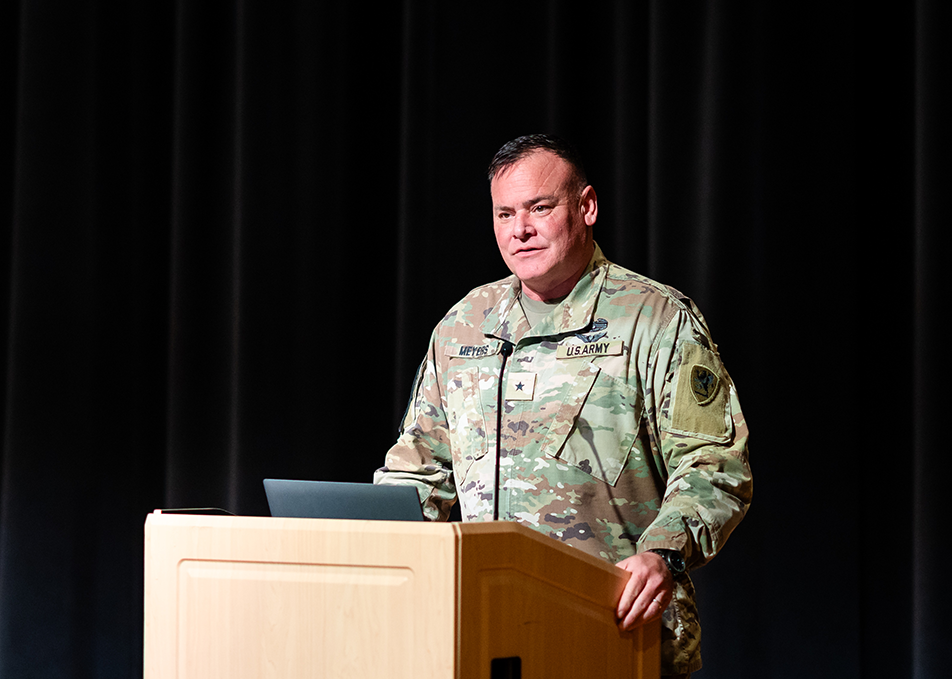From Lab to Warfighter—Faster: Brigadier General Scott Meyers Charts Bold Acceleration Strategy at ARC 2025

June 17, 2025 – Ann Arbor, MI
At the ARC Annual Review 2025, Brigadier General Scott Meyers, Assistant Adjutant General for Initiatives with the Michigan National Guard, delivered a mission-focused keynote titled “From Lab to Warfighter Faster: Methods and Partners for Transition.” Addressing over 250 defense leaders, researchers, and industry partners, Brigadier General Meyers underscored the urgency of accelerating innovation and transforming Michigan’s defense ecosystem into a launchpad for next-generation battlefield capabilities.
“In today’s threat environment, we cannot wait a decade to field new technology. If we are to win—especially against near-peer adversaries—we must radically shorten the cycle from concept to combat.”
Michigan: A Living Laboratory for Multi-Domain Integration
Brigadier General Meyers highlighted Michigan’s unmatched infrastructure for defense experimentation: from the 200,000-acre National All-Domain Warfighting Center (NADWC) spanning Camp Grayling and Alpena, to special-use airspace and littoral environments resembling real-world contested zones. These spaces support live-fire exercises, autonomous systems integration, and electromagnetic spectrum experimentation—making them critical venues for validating emerging technologies.
Initiatives like Northern Strike and Silent Swarm offer realistic, large-scale joint exercises where prototypes are tested not in isolation, but under operational pressure—with joint forces, contested logistics, and integrated fires.
ARC: Driving and Delivering Innovation Across the Lifecycle
At the heart of this defense innovation ecosystem is the Automotive Research Center (ARC), the U.S. Army’s academic Center of Excellence for Ground Vehicle Systems, headquartered at the University of Michigan.
The ARC plays a bidirectional role—a unique position that bridges foundational research and field integration:
- On one hand, the ARC pushes the frontier through groundbreaking research in mobility, human-machine teaming, digital twins, autonomy, AI, and power systems.
- On the other, the ARC pulls operational needs from its Army and National Guard partners to ensure that academic outputs directly address real-world challenges faced by warfighters.
“The ARC doesn’t operate in a vacuum,” Brigadier General Meyers noted. “It listens, it responds, and it prototypes with speed—integrating with GVSC and MING to ensure transition is not an afterthought, but a design principle.”
This continuous feedback loop between laboratory discovery and operational experimentation is what sets the ARC apart. Through its integration with GVSC, the ARC feeds into U.S. Army science and technology planning; through collaboration with MING and NADWC, it transitions models, sensors, and systems into validated, field-ready capabilities.
A Mutually Reinforcing Partnership
The keynote framed the ARC–GVSC–MING partnership as one that is evolving from collaboration to strategic interdependence. Brigadier General Meyers emphasized that by leveraging ARC’s simulation tools, workforce pipeline, and early-stage validation capabilities, technologies can be de-risked before entering costly field testing—accelerating U.S. Army modernization efforts.
“This is not just a center of academic excellence—it’s a partner in building combat advantage.”
ARC Director Prof. Bogdan Epureanu added:
“The ARC is where science meets the critical soldier needs. Our mission is not just discovery—it’s warfighter-centric delivery thorough strategic academia-government-industry partnerships.”
Dr. David Gorsich, GVSC’s Chief Scientist, echoed this alignment:
“ARC ensures we ask the right questions early and with purposeful feedback from warfighters, create, model and simulate solutions fast, and enter the field understanding what capabilities a technology can bring to the warfighter.”

